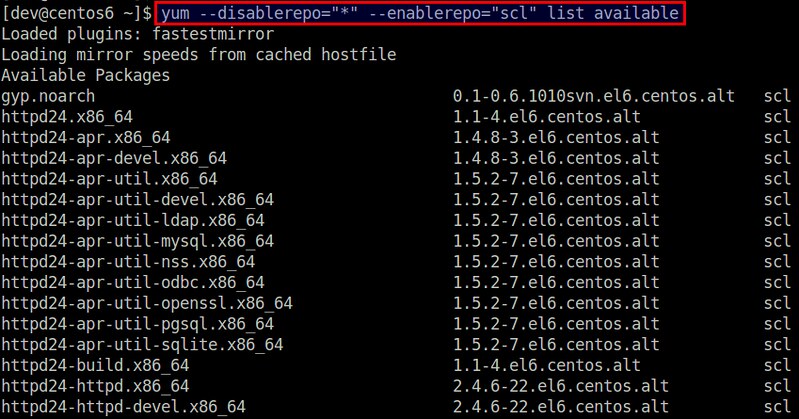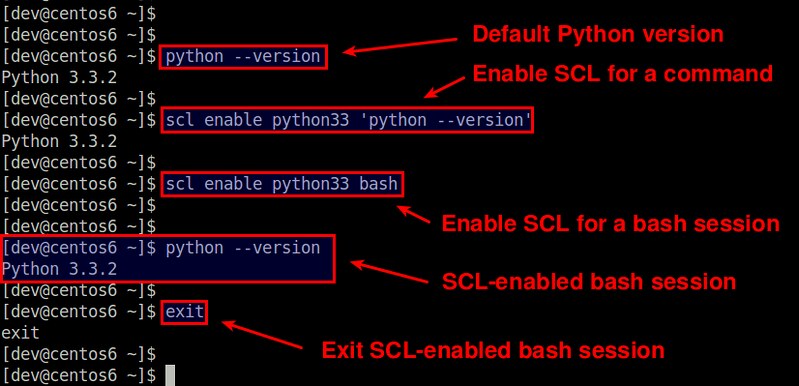mirror of
https://github.com/LCTT/TranslateProject.git
synced 2025-02-28 01:01:09 +08:00
105 lines
4.5 KiB
Markdown
105 lines
4.5 KiB
Markdown
How to enable Software Collections (SCL) on CentOS
|
|
================================================================================
|
|
Red Hat Enterprise Linux (RHEL) and its community fork, CentOS, offer 10-year life cycle, meaning that each version of RHEL/CentOS is updated with security patches for up to 10 years. While such long life cycle guarantees much needed system compatibility and reliability for enterprise users, a downside is that core applications and run-time environments grow antiquated as the underlying RHEL/CentOS version becomes close to end-of-life (EOF). For example, CentOS 6.5, whose EOL is dated to November 30th 2020, comes with python 2.6.6 and MySQL 5.1.73, which are already pretty old by today's standard.
|
|
|
|
On the other hand, attempting to manually upgrade development toolchains and run-time environments on RHEL/CentOS may potentially break your system unless all dependencies are resolved correctly. Under normal circumstances, manual upgrade is not recommended unless you know what you are doing.
|
|
|
|
The [Software Collections][1] (SCL) repository came into being to help with RHEL/CentOS users in this situation. The SCL is created to provide RHEL/CentOS users with a means to easily and safely install and use multiple (and potentially more recent) versions of applications and run-time environments "without" messing up the existing system. This is in contrast to other third party repositories which could cause conflicts among installed packages.
|
|
|
|
The latest SCL offers:
|
|
|
|
- Python 3.3 and 2.7
|
|
- PHP 5.4
|
|
- Node.js 0.10
|
|
- Ruby 1.9.3
|
|
- Perl 5.16.3
|
|
- MariaDB and MySQL 5.5
|
|
- Apache httpd 2.4.6
|
|
|
|
In the rest of the tutorial, let me show you how to set up the SCL repository and how to install and enable the packages from the SCL.
|
|
|
|
### Set up the Software Collections (SCL) Repository ###
|
|
|
|
The SCL is available on CentOS 6.5 and later. To set up the SCL, simply run:
|
|
|
|
$ sudo yum install centos-release-SCL
|
|
|
|
To enable and run applications from the SCL, you also need to install the following package.
|
|
|
|
$ sudo yum install scl-utils-build
|
|
|
|
You can browse a complete list of packages available from the SCL repository by running:
|
|
|
|
$ yum --disablerepo="*" --enablerepo="scl" list available
|
|
|
|

|
|
|
|
### Install and Enable a Package from the SCL ###
|
|
|
|
Now that you have set up the SCL, you can go ahead and install any package from the SCL.
|
|
|
|
You can search for SCL packages with:
|
|
|
|
$ yum --disablerepo="*" --enablerepo="scl" search <keyword>
|
|
|
|
Let's say you want to install python 3.3.
|
|
|
|
Go ahead and install it as usual with yum:
|
|
|
|
$ sudo yum install python33
|
|
|
|
At any time you can check the list of packages you installed from the SCL by running:
|
|
|
|
$ scl --list
|
|
|
|
----------
|
|
|
|
python33
|
|
|
|
A nice thing about the SCL is that installing a package from the SCL does NOT overwrite any system files, and is guaranteed to not cause any conflicts with other system libraries and applications.
|
|
|
|
For example, if you check the default python version after installing python33, you will see that the default version is still the same:
|
|
|
|
$ python --version
|
|
|
|
----------
|
|
|
|
Python 2.6.6
|
|
|
|
If you want to try an installed SCL package, you need to explicitly enable it "on a per-command basis" using scl:
|
|
|
|
$ scl enable <scl-package-name> <command>
|
|
|
|
For example, to enable python33 package for python command:
|
|
|
|
$ scl enable python33 'python --version'
|
|
|
|
----------
|
|
|
|
Python 3.3.2
|
|
|
|
If you want to run multiple commands while enabling python33 package, you can actually create an SCL-enabled bash session as follows.
|
|
|
|
$ scl enable python33 bash
|
|
|
|
Within this bash session, the default python will be switched to 3.3 until you type exit and kill the session.
|
|
|
|

|
|
|
|
In short, the SCL is somewhat similar to the virtualenv of Python, but is more general in that you can enable/disable SCL sessions for a far greater number of applications than just Python.
|
|
|
|
For more detailed instructions on the SCL, refer to the official [quick start guide][2].
|
|
|
|
--------------------------------------------------------------------------------
|
|
|
|
via: http://xmodulo.com/enable-software-collections-centos.html
|
|
|
|
作者:[Dan Nanni][a]
|
|
译者:[译者ID](https://github.com/译者ID)
|
|
校对:[校对者ID](https://github.com/校对者ID)
|
|
|
|
本文由 [LCTT](https://github.com/LCTT/TranslateProject) 原创编译,[Linux中国](https://linux.cn/) 荣誉推出
|
|
|
|
[a]:http://xmodulo.com/author/nanni
|
|
[1]:https://www.softwarecollections.org/
|
|
[2]:https://www.softwarecollections.org/docs/ |